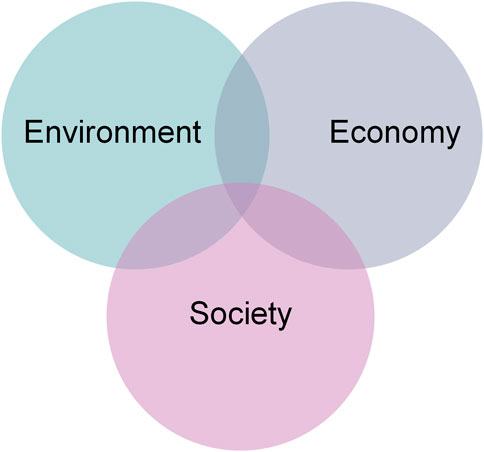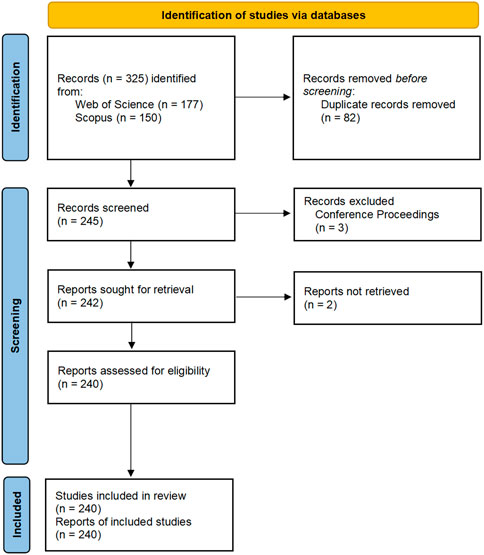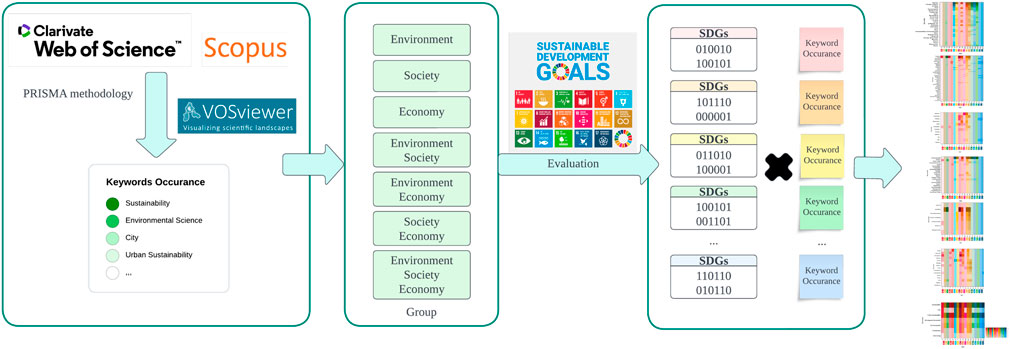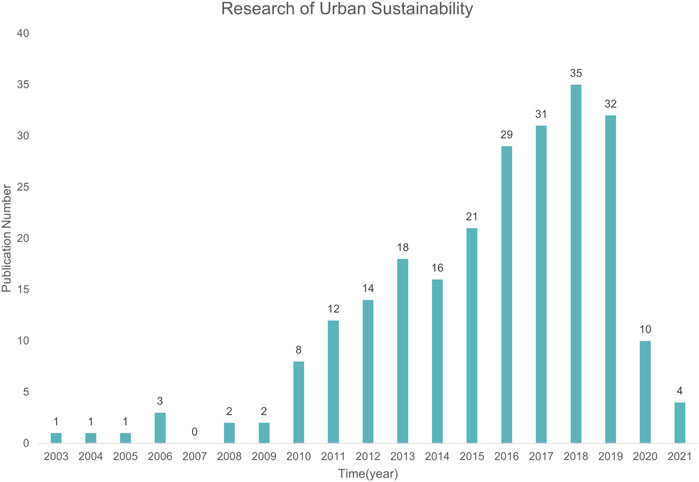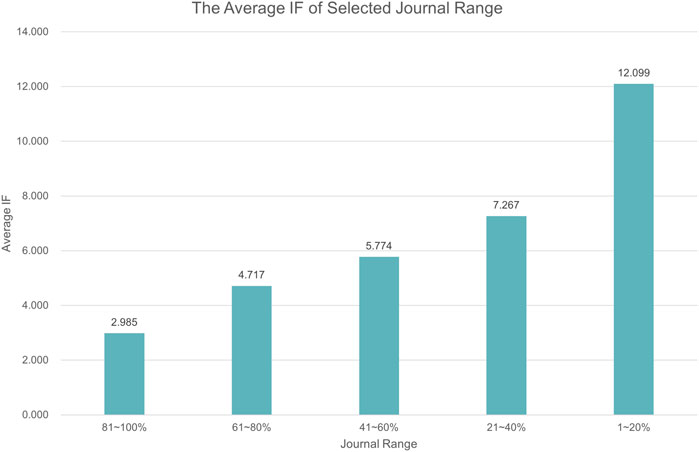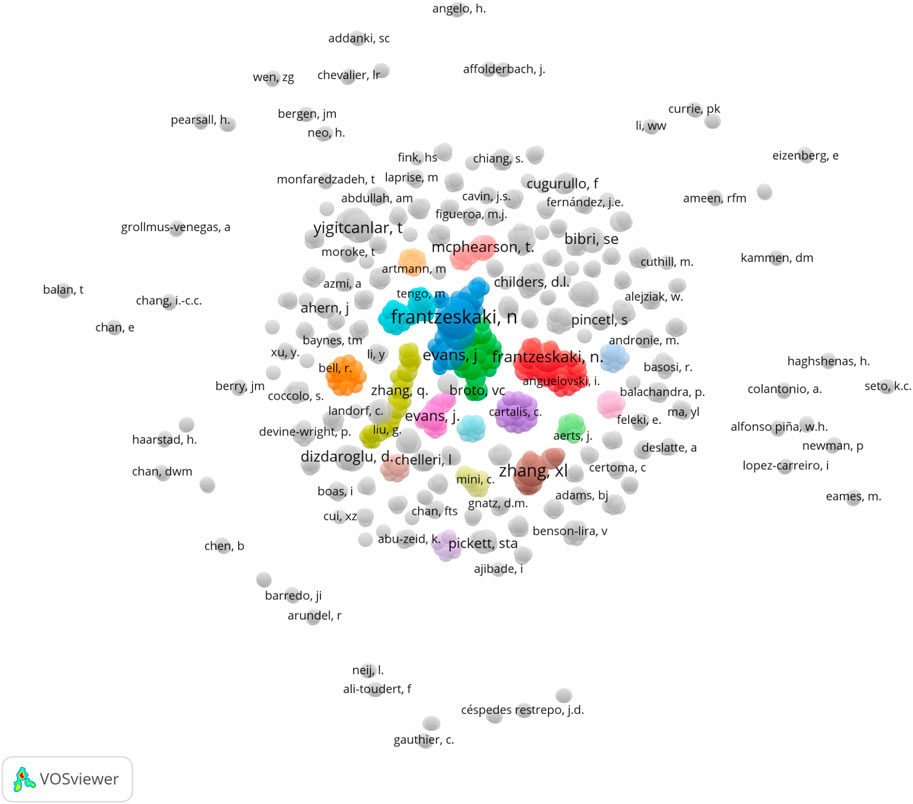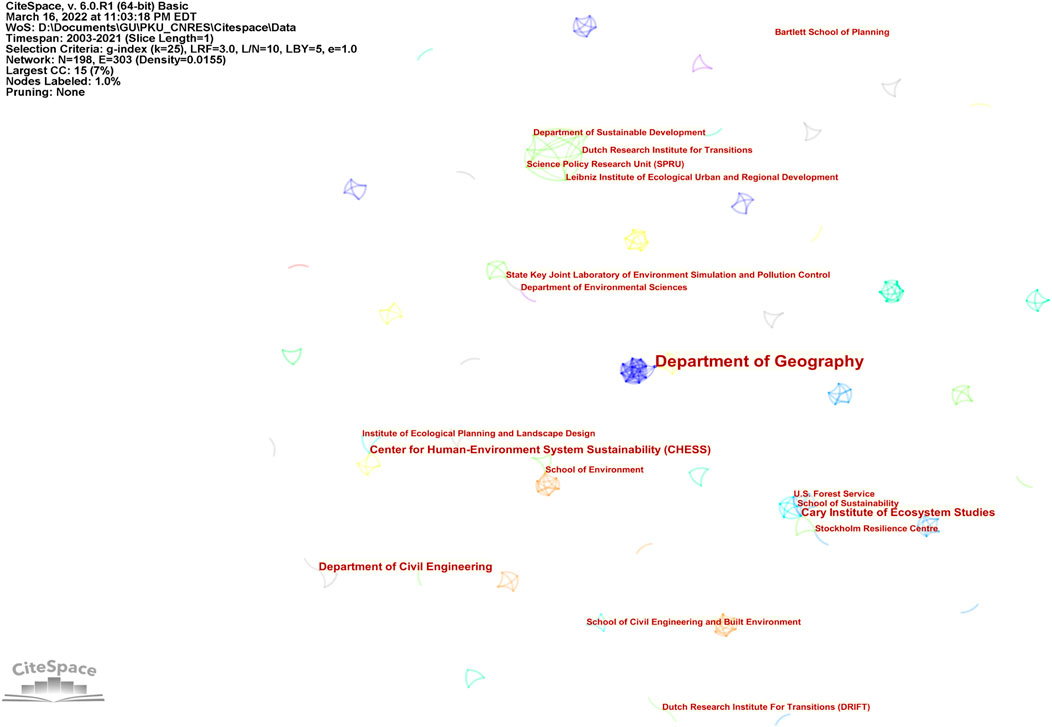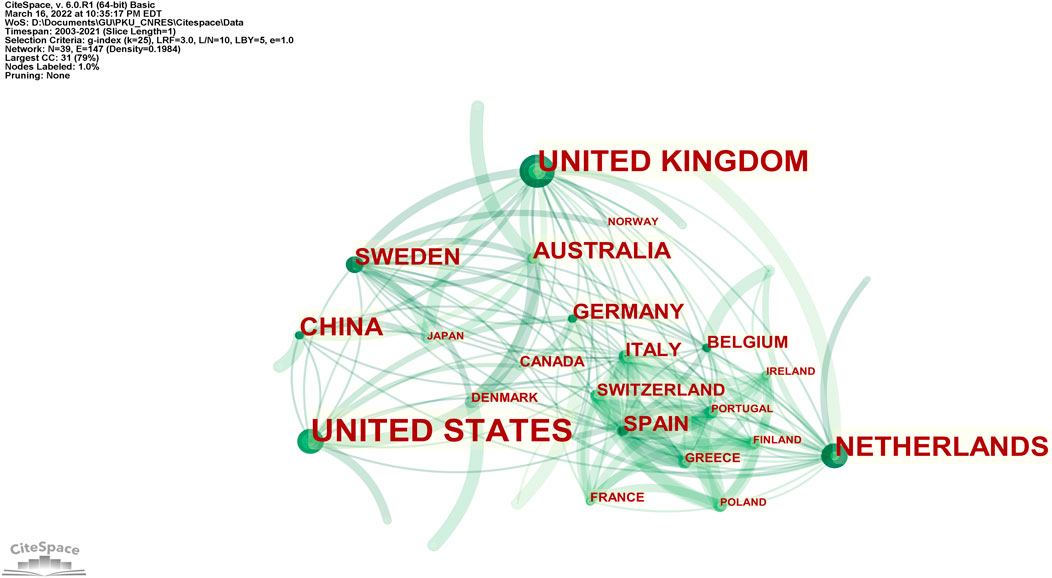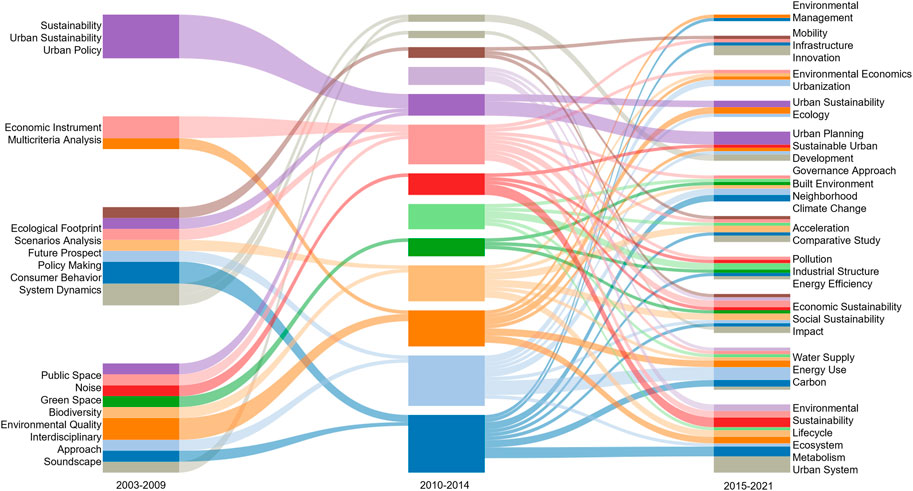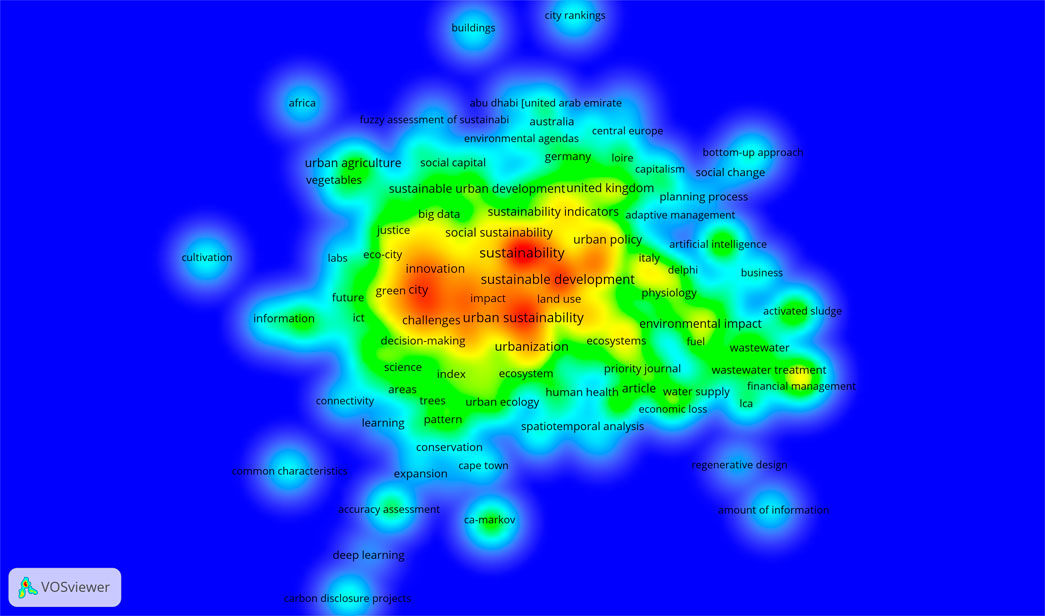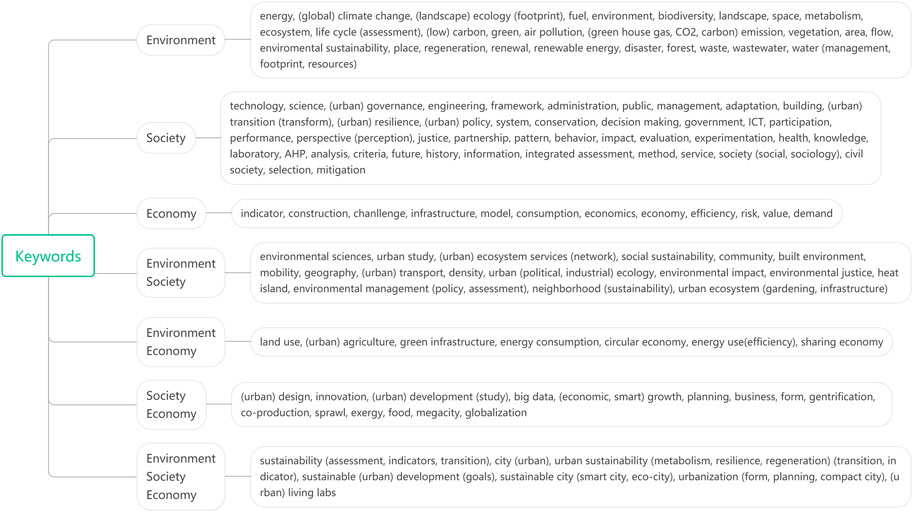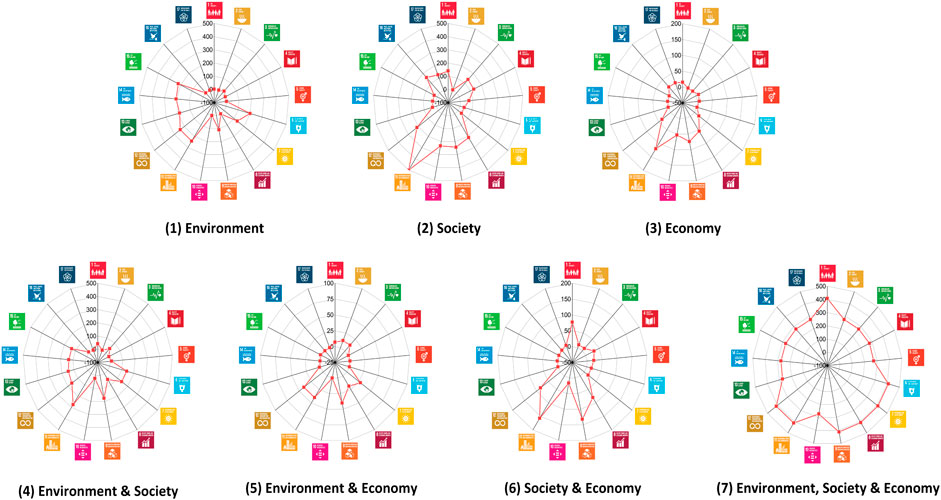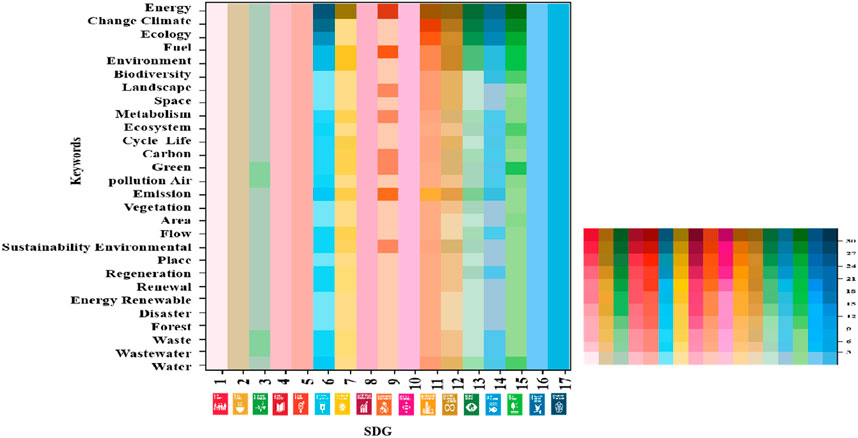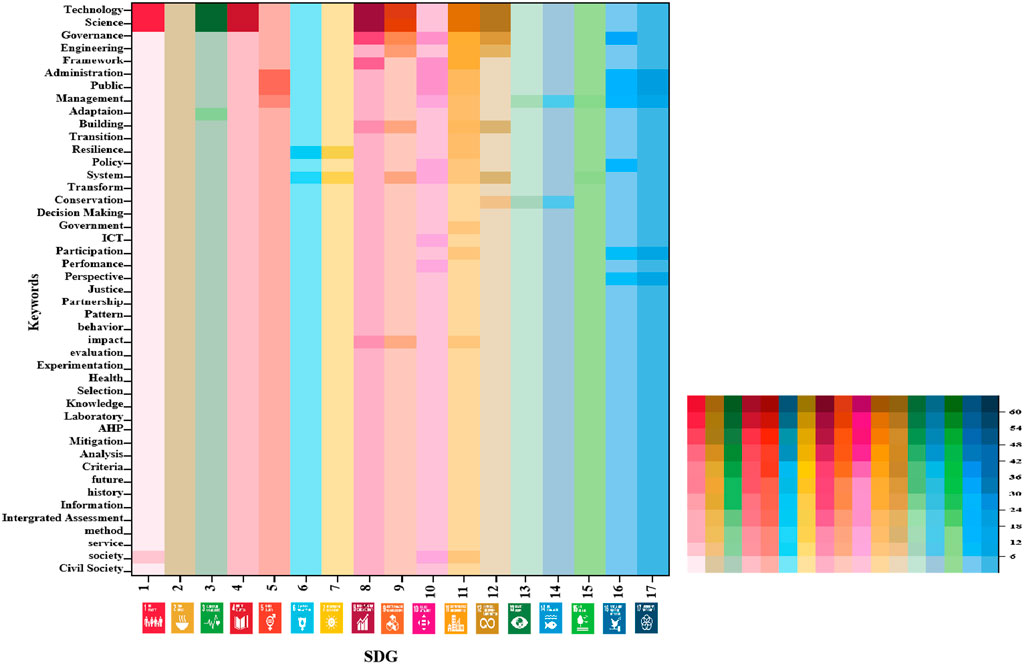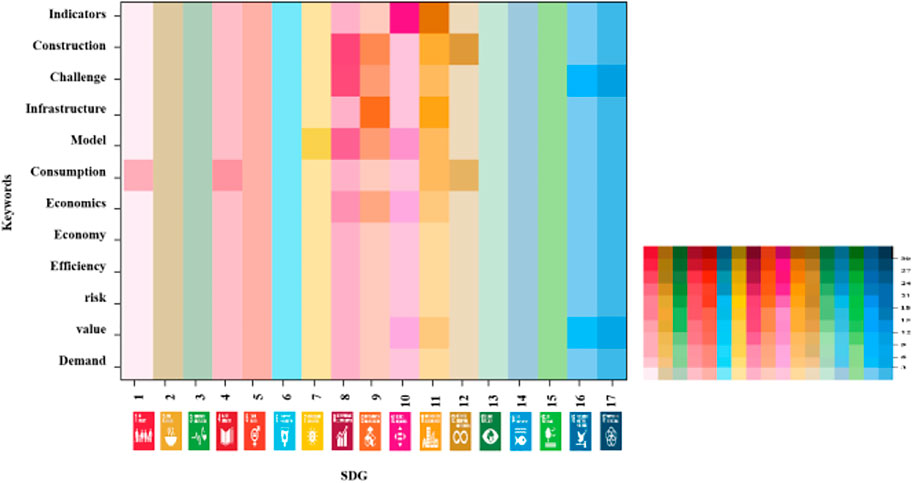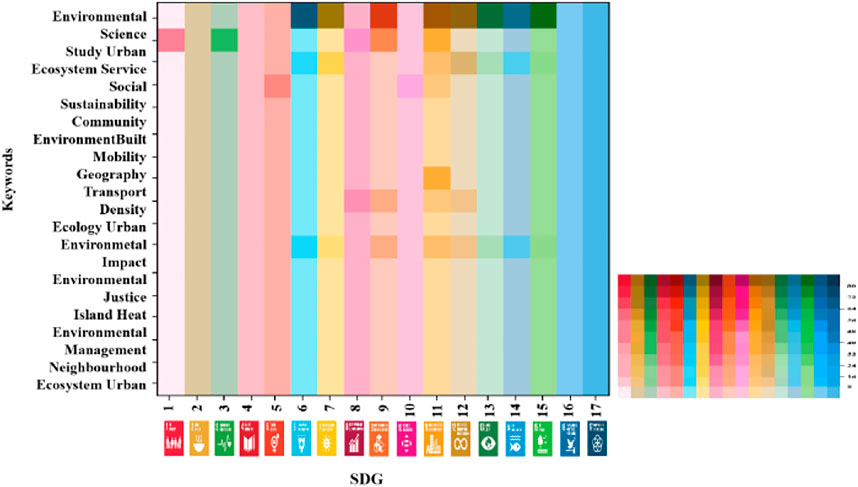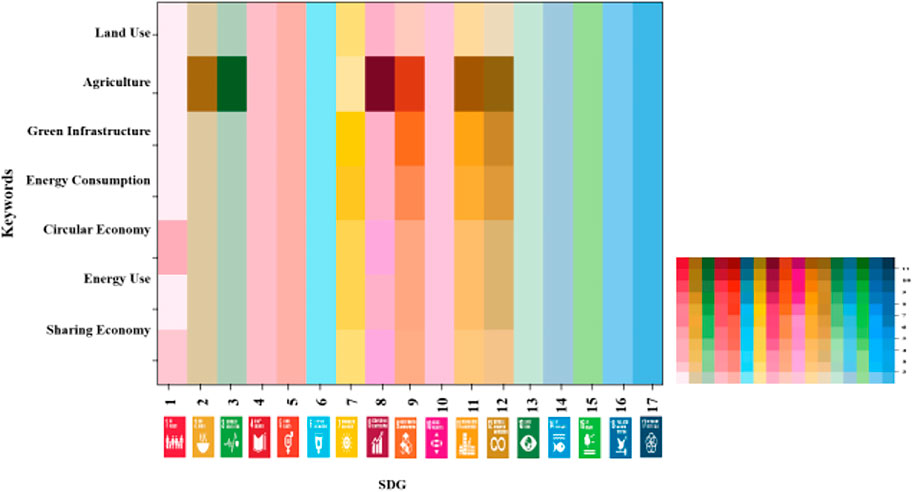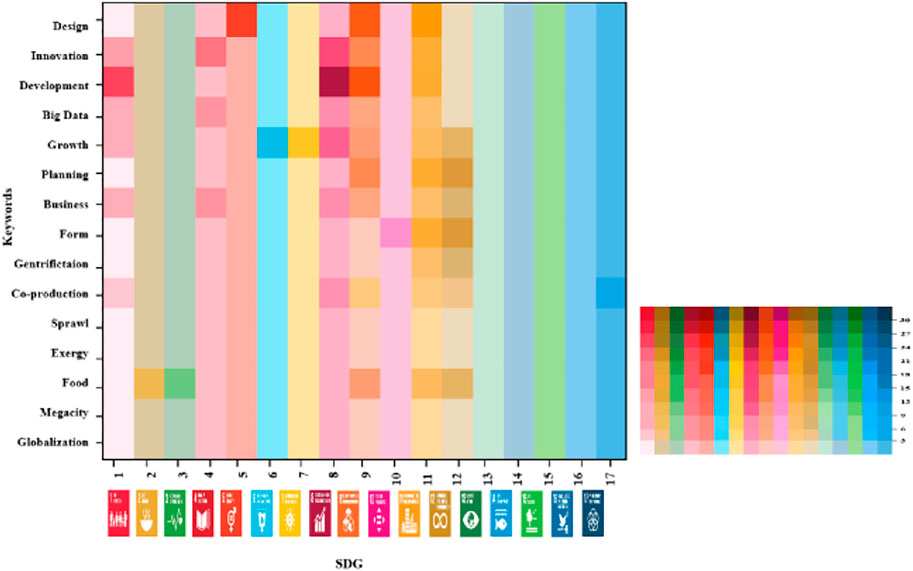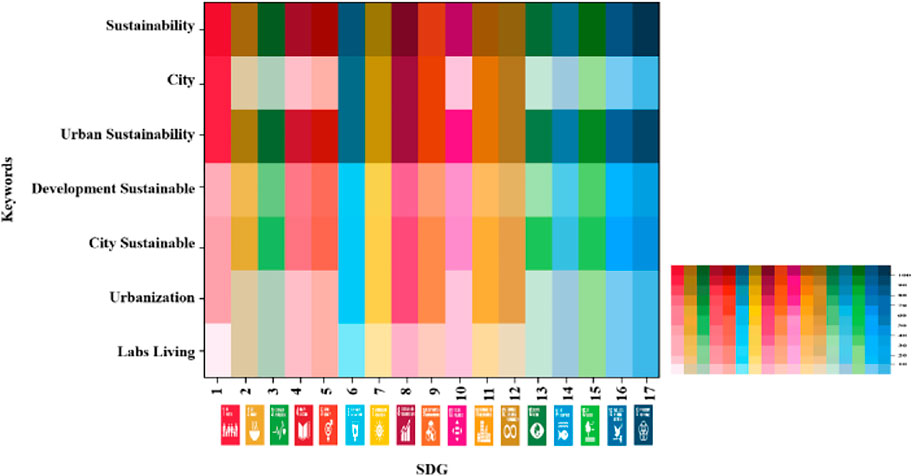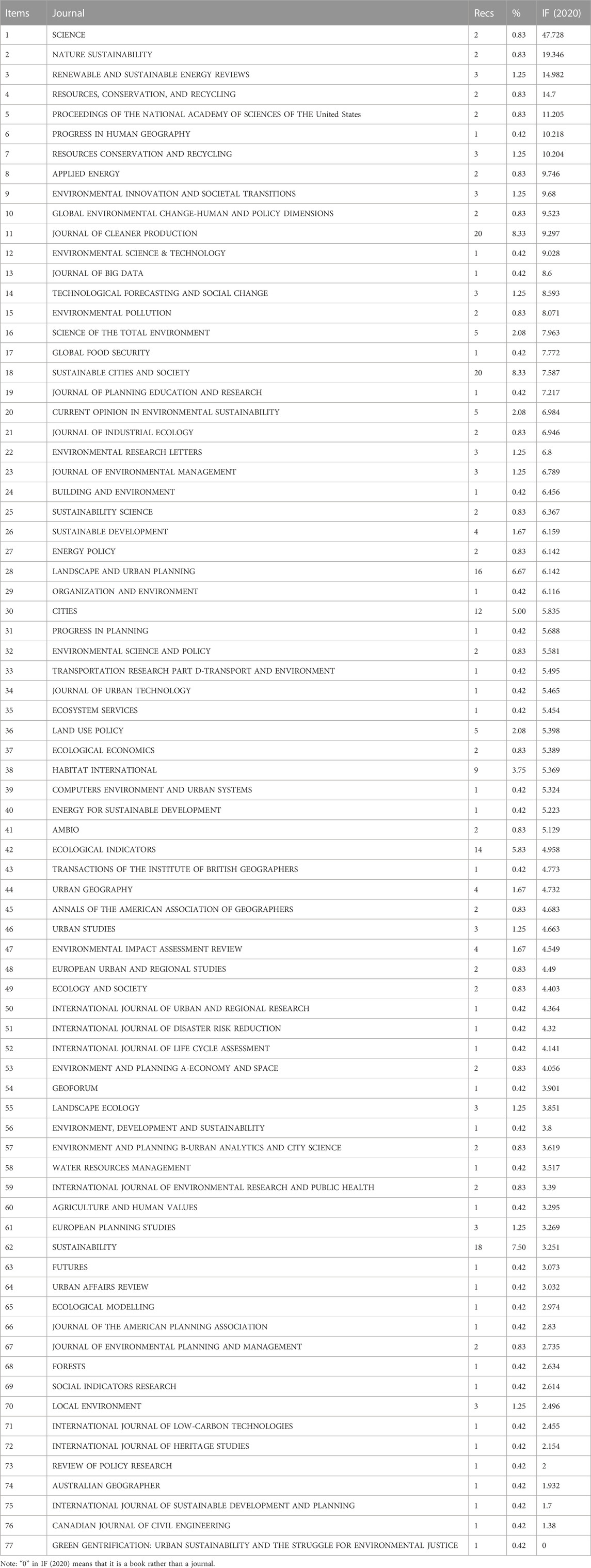Corrigendum: Data-driven comparison of urban sustainability towards sustainable urban development under sustainable development goals (SDGs): a review based on bibliometric analysis
- 1School of Government, Peking University, Beijing, China
- 2Institute of Governance, Peking University, Beijing, China
- 3Department of Public and International Affairs (PIA), City University of Hong Kong, Kowloon, Hong Kong SAR, China
- 4School of Energy and Environment (SEE), City University of Hong Kong, Kowloon, Hong Kong SAR, China
- 5Department of Economics, Georgetown University, Washington, DC, United States
As urbanization has increased rapidly, the issue of sustainability has become more prominent, and urban sustainability should be the key to achieving the sustainable agenda raised by the UN. This study combines bibliometrics and text mining to analyze the research progress of urban sustainability. A total of 1,031 keywords from 240 documents screened by the PRISMA method are coded to draw heat maps in accordance with the sustainable triple bottom line principle and its cross-scope (Environment, Society, Economics, Environment & Society, Environment & Economics, Society & Economics, Environment, and Society & Economics) with its emphasis on 17 SDGs. The innovation of this study is manifested as the use of heat maps. The results indicate that the existing relevant research still focuses on environmental protection. Besides the general “sustainability” topics, “land use,” “decision-making,” “green city,” and “eco-city” have been more discussed than others. For the SDGs, the SDG 6, 7, 9, 11, 12, and 15 represent clean water, affordable and clean energy, industry, innovation and infrastructure, sustainable cities and communities, and responsible consumption and production and life on land, respectively. Only a small part of the research has begun to focus on the sustainable development of the community. More comprehensive and complete insights should be gained into sustainable development. This study suggests that the research on urban sustainability will be further deepened, and it should be significantly integrated with SGDs and place a focus on the coupling of urban sustainability and economic growth.
1 Introduction
Many people seek out an urban life due to employment and education opportunities and the convenience involved in healthcare, transportation, and so forth. According to some previous investigations, the urban population will account for 70% of the global population by 2050 and become the vast majority in the world.
Nonetheless, as urbanization has been leaping forward, several risks (e.g., overloaded population, limited resources and space, and inequality) have exposed the potential hazards of living in a city and severely affected the ability to live a sustainable and high-quality life. As a result, sustainable development has become a hot topic in social research, and urban sustainability is becoming more and more important nowadays. Since this concept’s inception, various scholars have discussed urban sustainability from many perspectives, including what it is, what it can bring about, and how to realize it. Especially on the topic of urban construction, the above discussions cover almost all aspects from infrastructure to community environment.
Facing global challenges, the United Nations proposed the Sustainable Development Goals (SDGs) in 2015, which have been adopted by nearly all UN member states. The SDGs consists of 17 goals and 169 sub-goals designed to guide the 2030 Global Framework for Sustainable Development. Since urban populations account for a major part of global inhabitants, cities are vital centers for optimizing the SDGs agenda. Accordingly, SDG11 (sustainable cities and communities), one of the goals, is directly correlated with the sustainable development of cities. There are also many other relevant SDGs, including SDG6 (clean water and sanitation), SDG7 (affordable and clean energy), SDG12 (sustainable consumption and production), SDG13 (climate action), and so forth. The above targets are related to the urban risks listed earlier. Accordingly, the 17 SDGs should be considered during the study of sustainable urban issues.
From the aspect of common urban development factors (e.g., environment, society, and economics), most scholars’ insights into urban sustainability primarily follows two directions: the natural environment and society construction. Most scholars still simply consider urban sustainability as urban environmental sustainability, and only a few studies have begun to focus on the sustainable development of urban society. The SDGs that mainly relate to those focuses are SDG6, 7, 9, 11, 12, and 15. There is also little research on the sustainable development of urban economics, and many of the studies are concept explanations rather than practical applications. The current state of research is too lacking to be able to meet the 17 sustainable development goals set by the UN.
Existing research on urban sustainability comprises several aspects. Apart from the general concept discussions (Vojnovic, 2014; Wu, 2014; Wolfram et al., 2016), researchers are more focused on estimating the progress of urban sustainability, as they turned to form different models from various factors and assessment criteria (Berardi, 2013; Ali-Toudert and Ji, 2017; Almeida et al., 2018; Ameen and Mourshed, 2019). The above theoretical contents account for more than half of the example studies.
When exploring the specific areas of urban sustainability development, new topics include smart cities (Bibri and Krogstie, 2017; Bibri, 2019; Martin et al., 2019; Yigitcanlar et al., 2019), urban resilience (Turcu, 2012; Ajibade, 2017; Elmqvist et al., 2019), and urban metabolism (Pincetl et al., 2014; Currie and Musango, 2017; Cui, 2018). Such topics are naturally view urban environmental and energetic sustainability as central issues of urban sustainability, thus there is also some research on the consumption of specific resources including water and sewage (Marques et al., 2015; Li and Bergen, 2018; Yang et al., 2018), land and forests (Escobedo et al., 2011; Seto et al., 2012), and food and agricultures (Specht et al., 2014; McClintock, 2018; Armanda et al., 2019).
From the research mentioned previously, it is obvious that a huge part of the current practical research on the topic of urban sustainability is focused on the environment, while only 10% are related to social sustainability (Eizenberg and Jabareen, 2017; Sampson, 2017); there is even less about education (Trencher et al., 2013) and business (Gauthier and Gilomen, 2016) regarding this topic.
This current research progress situation is just like the result derived from the semantic collections of urban sustainability based on seven dimensions. The keywords mostly concentrate on environment-associated dimensions. Numerous keywords can also be seen in society-associated fields, such as “what the society can do to improve the environment sustainability”. Few keywords focus on economy-associated fields, indicating the lack of research and discussions on urban economic sustainability.
Against the previous background, this study places a major focus on the effect of urban sustainability on 17 Sustainable Development Goals (SDGs). Since the collections of keywords shall indicate the topic of conception, the frequency of keywords is selected in this study to determine the data-driven interaction between urban sustainability and SDGs in seven dimensions (i.e., Environment, Society, Economy, Environment + Society, Environment + Economy, Society + Economy, and Environment + Society + Economy), enlightened by the principle of sustainable development of the Triple Bottom Line (TBL) (Figure 1) in this study. It can be a persuasive model for governors and policymakers to propose and evaluate proper policies and plannings.
This study is organized as follows: After the introduction, the data sources and research methods are presented. Thereafter, the analysis and results will be explained in three parts. The first part is the bibliometric analysis of basic publications information, and the second one is the texting mining for this topic. The above two parts can offer common information of recent research on urban sustainability. The last part is the core interpretation of the relationship between US and SDGs with eight heatmaps.
2 Methodology
Bibliometric analysis is widely used for the review of large volumes of published and unstructured data in different areas (Merediz-Sola and Bariviera, 2019; Donthu et al., 2021; Goh and See, 2021). Based on the statistical methods, it can offer comprehensive information for future research such as specific domain history, hot topic prediction, and co-citation analysis. Moreover, many pieces of functional scientific mapping software like VOSviewer and Citespace greatly enhance the applicability and convenience for dynamic and clear views of all the critical elements.
In this study, version 1.6.18 of VOSviewer and version 5.8. R3 of Citespace are combined for the basic information of urban sustainability, and heatmaps are also used for the content comparison.
The Preferred Reporting Items for Systematic Reviews and Meta-Analyzes (PRISMA) is applied throughout this study (Page et al., 2021) to ensure that the bibliometric literature review is systemic, transparent, repeatable, and reliable. Though the PRISMA method originates from healthcare interventions, it has been applied to numerous reviews in various areas (Correia et al., 2020; Gokhale et al., 2020). As depicted in Figure 2, the PRISMA flow diagram mainly comprises three parts: Identification, Screening, and Included.
Web of Science (WoS) and Scopus are selected as the database sources to extract relevant publications in English with the topic terms (urban sustainability) since they cover numerous and representative literature. Though Google Scholar can provide free access and more coverage, it is less reliable than the subscriber-based databases, whereas it can be continuously employed on studies and additional resources searching for cross-checking and replenishment. Given the time span of all related studies, the search period for Scopus is from 1980 to 2021 and that for WoS is from 1990 to 2021. The strings of urban sustainability without synonyms were only searched to ensure comparability. The queries are presented as follows: Topic (urban sustainability) in WoS and TITLE-ABS-KEY (urban AND sustainability) in Scopus. Only studies written in English and published as a book, meeting, article, early assess, review article, review, book chapter, or conference paper are retained. Table A1 in the Appendix lists the total queries. Next, through the mixture of two databases, duplicated records, anonymous studies, and works that are not related to the topic of this study are excluded. With the inspection of full-text accessibility, 240 studies remain for further bibliometric analysis, which is managed by Endnote. The paper quantity of coverage can be calculated as 240/325 = 73.85%.
The overall overview of this study is illustrated in Figure 3, and the research framework is illustrated in Figure 4. In this study, 1795 original keywords of the selected studies for urban sustainability are recorded. Subsequently, VOSviewer is used to further analyze the co-occurrence of keywords. Before this analysis, several meaningless keywords have been deleted, and keywords with similar meaning and different abbreviations and symbols, singular and plural, and uppercase and lowercase letters (e.g., ‘Climate-Change’, ‘climate change’; ‘cities’, and ‘city’) have all been merged and unified; otherwise, VOSviewer will mistakenly recognize them as different. After data cleaning, all those keywords are divided into seven dimensions (Environment, Society, Economy, Environment + Society, Environment + Economy, Society + Economy, and Environment + Society + Economy) to clearly clarify the concept.
For the interaction between the dimensions and SDGs, the database of this study is constructed with the previous keywords. With the SDGs and their contents, and the reported query keywords, keywords are coded into matrixes containing only 0s and 1s, and then the product of the occurrence is summed up and the coding is used for the value of heatmap. The color scale is the same as the representative color of 17 SDGs for easy identification.
3 Results
3.1 Bibliometric contrast
3.1.1 The current state of publications
The quantity of publications can indicate the research tendency. As depicted in Figure 5, concern for urban sustainability increased with time. In accordance with the number of publications, it can be divided into three stages as follows:
The original stage is ∼2009, with a focus on comprehensive urban sustainability, and the development of modelling and criteria. Social sustainability and urban resilience are the first two relevant fields of urban sustainability.
The second stage is 2010–2014. People tended to place a greater emphasis on urban sustainability. In this period, the importance and implementation of this topic were mentioned much more, as indicated in the quantity and quality of studies. Moreover, the relevant fields of urban sustainability were emerging swiftly and endlessly, including specific resources (e.g., water (El-Sayed Mohamed Mahgoub et al., 2010), forest (Escobedo et al., 2011) and land (Seto et al., 2012)), as well as food and agriculture (Tornaghi, 2014) and urban metabolism (Pincetl et al., 2014). Furthermore, the number of studies in the two existing fields, urban resilience (Ahern, 2011) and social sustainability (Dempsey et al., 2011; Yung et al., 2014), had been mushrooming rapidly.
An explosive growth was experienced at the third stage (2015∼) when the United Nations proposed the SDGs agenda, which aims to ensure that all people enjoy peace and prosperity by 2030. At this stage, it can be expected that discussions on urban sustainability will increase and be more nuanced. Topics regarding Energy (Kammen and Sunter, 2016) & Resource (Larsen et al., 2016), Social Sustainability (Ilieva and McPhearson, 2018), and Urban Resilience (Elmqvist et al., 2019) have become hotspots. Scholars have made progress in the existing related fields noted at the second stage and produced new ideas on urban sustainability with the development of modern data science. Thus, research on smart cities (Bibri and Krogstie, 2017; Bibri, 2018; Bibri, 2019), urban living labs (Bulkeley et al., 2016; Voytenko et al., 2016), and other methods (Kong et al., 2020) based on data and technology for urban sustainability have grown exponentially. Moreover, the concept of urban sustainability entered public daily knowledge. Notably, business innovations (e.g., sharing economy (Ma et al., 2018) and circular economy (Fratini et al., 2019)) have become a new relevant field in this area, suggesting that public partnership of urban sustainability has been developing significantly.
3.1.2 Analysis of journals
As depicted in Table A2 in the Appendix, journals with high IF over 10 include Science (47.728), Natural Sustainability (19.346), Renewable and Sustainable Energy Reviews (14.982), Resources, Conservation and Recycling (14.7), Proceeding of the National Academy of Sciences of the United States of America (11.205), Progress in Human Geography (10.218), as well as Resources of Conservation and Recycling (10.204). Six of the above selected journals have published more than 10 studies in this area. They are Journal of Cleaner Production (20 with IF 9.297), Sustainable Cities and Society (20 with IF 7.587), Sustainability (18 with IF 3.251), Landscape and Urban Planning (16 with IF 6.142), Ecological Indicators (14 with IF 4.958), and Cities (12 with IF 5.835). The above result reveals that Journal of Cleaner Production is popular and holds a critical significance in this area. As depicted in Figure 6, the average IF over three accounts for over 80% for urban sustainability, such that the above selected journals significantly represent high quality.
3.1.3 Authorship analysis
The co-authorship network contributes to the analysis of the leading and productive scientists and their associations. As depicted in Figure 7, Frantzeskaki, N. has the most publications with the biggest impact among all the authors. She was mainly focused on urban sustainability transitions and urban living labs (ULL), especially ULL’s impact on urban sustainability transitions. She took cities in Europe (Frantzeskaki and Rok, 2018; Elmqvist et al., 2019), especially Rotterdam (Frantzeskaki et al., 2014; von Wirth et al., 2019), Malmo (von Wirth et al., 2019), and Genk (Gorissen et al., 2018), as cases to study civic partnership and urban living labs, and their impact on urban sustainability transition. Apart from that, she also delved into various theories of urban sustainability transition (Wolfram et al., 2016; Luederitz et al., 2017), identified and mapped out the current development status in this field, and derived strategic recommendations and evaluation tools for current policy planning and future academic research, where she pointed out the important role of urban living labs and civic society co-partnership.
3.1.4 Institution and country analysis
As shown in Figure 8, the main research institutions are universities and international organizations, and there are no authoritative institutions currently in this field. According to the records of this study, Lund University and several other Chinese and European universities are more productive than others. However, this is not as compatible as the author analysis; one possible reason is that more scholars choose to collaborate on this topic, and productive authors like Frantzeskaki, N. do not always act as the corresponding author or the first author, while Citespace analysis focus on the address of the first author. Thus, the most productive institutions are difficult to determine.
Country network analysis can indicate collaborations between different countries and the research distribution. As depicted in Figure 9, the United States is the most productive country with 26 studies, followed by the UK with 23 studies, the Netherlands with 17 studies, and China with 13 studies. From the perspective of this study, though the UK is not so prominent in other analyses, this analysis result is still quite persuasive since it is compatible with the place where the most productive institution and author is. Frantzeskaki, N. is from Utrecht University, in the Netherlands; the second most productive author, McCormick, M, belongs to University of Kansas, in the United States. Moreover, the country network analysis result is quite compatible with the institution network result, such that its credibility can be confirmed.
3.2 Text-mining contrast
The terms have been extracted from the title and abstract of the selected corpus to indicate the critical information of the topics. With the alluvial diagram, the static network can be transferred into dynamic network (Ruan et al., 2017) so that representative terms will be merged or split (Rule et al., 2015) to portray the development of the terms in this field.
According to the analysis of the current state of publications, time slices were set as 3 to indicate the gradual prosperity of this discipline. As depicted in Figure 10, there are 4 clusters at the first period, from 2003 to 2009, when the topics are mainly focused on “sustainability,” “economic instrument,” “ecological footprint,” and “public space,” three of which further continued into the following periods. “Sustainability” became broader in the future, then split to become focused on “urban planning”. It means that this topic has been widely accepted, and in the analysis urban-related contents of this study have become more valuable. “Economic instrument” also became broader at the second stage, whereas it was extensively split into various topics at the third stage. This result suggests that economic instruments have been extensively accepted in urban sustainability planning, although it will not be specifically noted now. Other topics at the first stage may not be so widely accepted since similar but advanced topics will arise.
Another interesting trend is that “urban sustainability indicator” emerged at the second stage, and it also later became widely applied. This trend is consistent with the situation mentioned previously at the current stage of publication. At the third stage, all the topics developed from the first and second stage and newly included suggest that more concerns for urban sustainability (e.g., “metabolism” and “social sustainability”) have emerged, consistent with the third stage of the mentioned situation.
The analysis suggests that sustainability and urban development are critical to the studies. However, more focus is now applied to deal with the contemporary concerns on this topic due to the development of the urban planning and data-driven methods, thus confirming that people’s requirements for urban sustainability are currently more diverse.
Thus, in the following part, the implication of urban sustainability will be further illuminated. Moreover, all the keywords are extracted from the studies to semi-quantize the interaction of SDGs to offer a novel and reliable way to analyze urban sustainability.
3.3 Content contrast
3.3.1 Analysis of keywords
Density visualization is used to analyze the co-keywords. Each keyword has a color to represent the density. Color ranged from blue to green to orange. The larger the number of documents including a certain keyword, the higher the weight of the keyword, then the closer the color of the keyword to orange.
As shown in Figure 11, when it comes to the topic of urban sustainability, there are several keywords in orange, such as “sustainability,” “urban sustainability,” “sustainable development,” “social sustainability,” “urban policy,” “land use,” “decision-making,” “green city,” and “eco-city.” Therefore, representative keywords of urban sustainability can be well classified into environment, society, governance, and their mixed categories. And several keywords indicate the same meanings, like “sustainability” and “sustainable development,” which are summarized as “sustainability” to reduce unnecessary workload. In accordance with the mentioned rules, all the keywords are further organized into several semantic collections, which can well represent the specific topics of urban sustainability under seven dimensions. This is depicted in Figure 12.
major focuses from the environment dimension comprise “Energy,” “(Global) Climate Change,” “Ecology (footprint),” “Fuel,” “Environment” “(Carbon) Emission,” and “Biodiversity.” To be specific, energy-related focuses are more frequently mentioned in the study.
From the society dimension, “Science and Technology,” “(Urban) Governance,” “Engineering,” “Framework,” “Resilience,” “Administration,” and “Public” are often mentioned. Knowledge and administrative planning refer to the two major ideas in socially concerned contents.
The common focuses from the economy dimension cover “Indicators”, “Construction”, “Challenge,” “Infrastructure,” “Model,” “Consumption,” and so forth.
The common focuses from the environment and society dimension include “Environmental Science,” “Urban Study,” “Geography,” “Ecosystem Service (Network),” “Urban (Industrial & Political) Ecology,” and “Social Sustainability.”
From the environment and economy dimension, “(Urban) Agriculture,” “Green Infrastructure,” and “Energy Consumption” are the common focuses.
From the society and economy dimension, “(Urban) Development (Study),” “(Urban) Design,” “Planning,” “Form,” and “Innovation” are the common focuses.
The common focuses from the environment, society, and economy dimension comprise “Sustainability (Assessment, Indicators, & Transition),” “City and Urban,” and “urban sustainability (Metabolism, Resilience, & Regeneration) (Transition & Indicator)”. In fact, numerous topics are repeated in this section, since they are the main ideas discussed in various aspects.
3.3.2 Urban sustainability and SDGs
Due to the different dimensions of urban sustainability and SDGs, the summary of semantic collections is adopted in this section to analyze the interaction of urban sustainability towards SDGs in depth. Since the respective semantic collection has a different number of keywords, these keywords can be coded as 0 or 1 when matching with the respective SDG. Thus, the summary of the product between a wide variety of occurrences and codes can be well semi-quantized to illuminate connections between SDGs.
Heatmaps and radar maps in seven dimensions are adopted for in-depth research to give a comprehensive overview of interlinkage between the 17 SDGs and urban sustainability.
From environment dimension (Figure 13), urban sustainability has more interactions with SDG 6, 7, 9, and 11–15. One vital pillar of urban sustainability is energy, which contain fuels, carbon, water, and forest resources and is related with emissions, pollutions, and disaster, which can be well consistent with those SDGs. Figure 14(1) depicts the concerns for resources and biodiversity matters, especially noted in the mentioned SDGs. Notably, SDGs 11–15 are goals for sustainable cities, consumption, climate, and biodiversity, thus adding importance to environmental protection with human coexistence (Chen and Chen, 2015; Kammen and Sunter, 2016).
In society dimension as reflecte by Figure 15, apart from the common pursuit of SDG11 for sustainable cities and communities, different pillars have exhibited different interactions with a wide variety of SDGs. SDGs 8–12 are more related to “Technology”, “Science”, “Governance”, and so forth. From the above dimension, economic growth, innovation & infrastructure, equalities, and communities are covered (Certoma et al., 2015). The above result is consistent with that in Figure 14(2), where SDGs 8–12are covered much more than others.
Comparatively, Figure 16 indicates that not many pillars in economy dimension interact with SDGs, or this dimension has not yet been referenced much. With the result in Figure 14(3), SDGs 8, 9, and 11, with the intention for economic growth, industry, and sustainable cities, have more interaction with the main ideas in this field. An interesting and noteworthy point is that the most often referred pillar, “Indicators”, is often used in evaluation models for sustainability assessment development (Pupphachai and Zuidema, 2017; Ameen and Mourshed, 2019) instead of economic assessment. This point indicates that, at present, the economy dimension is not given too much attention, and great prospects for urban sustainability with economy development exist in the long term.
In the environment and society dimension, although there are many pillars, only “environmental studies” has much weight. Moreover, a clear trend emerges that, according to Figure 14(4) and Figure 17, urban sustainability has more interactions with SDGs 6, 7, 9, and 11–15. This outcome is close to that in environment dimension, but not so centralized. The possible reason for this result is that most of the research listed is focused on environmental protection terms, whether it is technology and science research, evaluation assessment, or government policy planning. Given the trend analyzed in the text mining contrast, such academic research will attach more importance to social sustainability among neighborhood and communities in the near future, and it can be anticipated that the pillars will interact more with the society-associated SDGs.
As mentioned above, economy dimension is experiencing a lack of attention, although some pillars can still be found in this environment and economy dimension. As depicted in Figure 14(5) and Figure 18, pillars in this dimension show that urban sustainability has more interactions with SDGs 7–9, 11, and 12, which takes on a certain significance in “clean energy,” “economic growth,” and “responsible consumption.” “Agriculture” refers to the most popular term here, which, apart from the common SDGs, also interacts with SDG2 and 3 to ensure “zero hunger” and “health” (Specht et al., 2014; Armanda et al., 2019). In general, the above topics start to appear at the latter stage, suggesting a gradual emphasis on social sustainability (McClintock, 2018).
When it comes to the dimension of society and economy, the result is similar to, but not the same as, the dimension of solely society. According to Figure 14(6) and Figure 19, pillars interact more with SDGs 1, 8, 9, and 11, which add importance to “no poverty,” “decent work and economic growth,” “industry, innovation, and infrastructure,” and “sustainable cities and communities.” Compared to society, the above terms all affect the economic outputs, but due to the difficulty of measurement and assessment of “social sustainability,” the social side of SDGs are not clearly expressed.
Most of the keywords appearing in Figure 20 are conceptual nouns that are strongly related to SDGs, as shown in Figure 14 (7). The most comprehensive topics are grouped in the environment, society, and economy dimension. Since urban sustainability is employed as the main topic in this study, most pillars in this dimension (“urban sustainability” and “sustainable development”) are significantly correlated with all SDGs.
In brief, two findings are achieved in the analysis of the interactions between urban sustainability and Sustainable Development Goals.
One is that urban sustainability research seems to be more focused on archiving quantifiable environmentally sustainable development goals at the present stage due to the difficulty of measurement and assessment of “social sustainability”. However, with the development of contemporary society and the progress of academic research, the amount of existing research on social sustainable development goals begins to increase.
The other is that there are relatively few studies on economy dimension. In the long term, it still has a large space for development.
4 Discussion
The research results of all the academic literatures may have certain deviations due to the search and statistical methods of this study, whereas the research biases of urban sustainability that are listed above are generally consistent with the expectations. This phenomenon may occur for several reasons.
On the one hand, researchers and policy makers do not have a comprehensive and sufficient understanding of urban sustainability, or do not treat all dimensions in a unified manner. Relevant research is bound to investigate realistic urban development policies as the research object. Even if researchers themselves have a full understanding, policy makers may not have a perfect understanding of urban sustainability development, which may lead to current policies being only focused on urban environment sustainability, leading to bias in research.
In addition, sustainable development is an important indicator for assessing urban development. Compared with social sustainable development, which is difficult to quantify, and economic sustainable development, which is easy to include in other economic development indicators, environmental sustainability development can best reflect the progress of urban sustainability development at the current stage and is therefore the easiest to select and implement by policy makers.
As revealed by the idea, all sectors of society should improve their overall understanding of urban sustainability and pay more attention to sustainable social and economic development factors that are not easily quantified. At present, the research results suggest that policy researchers are gradually paying more attention to social sustainability, and they should also have a more comprehensive analysis of economic sustainability. Policy makers should also be more aware of this, and formulate sustainable development policies from multiple perspectives, including environment, society, and economic development, and strive to build a sound sustainable development society.
5 Conclusion
In this study, bibliometric methods are adopted to examine academic literature on urban sustainability. Moreover, this study evaluates and compares current urban sustainability research and their relativeness with the UNs SDGs through the innovative use of the interactions between keywords in accordance with the principle of sustainable development of the Triple Bottom Line from seven dimensions, namely, Environment, Society, Economy, Environment + Society, Environment + Economy, Society + Economy, and Environment + Society + Economy. This study aims to effectively clarify and supplement the latest progress on urban sustainability in the SDGs achievements and provide constructive advice for subsequent urban sustainable development assessment, policy design, and implementation.
According to the above-mentioned analysis, the most prominent urban sustainability research scholar is Frantzeskaki, N., who focuses on urban sustainability transitions and urban living labs (ULL), especially ULL’s impact on urban sustainability transitions. Lund University in Sweden, and several other Chinese and European universities, are more productive than others in urban sustainability research and have more cooperation and radiation effects on other institutions.
The result achieved through the text mining process suggests that the development of urban sustainability has undergone three periods. The term “urban sustainability” arises from concerns of “sustainability,” “economic instrument,” “ecological footprint,” and “public space” at the first stage, and then it progressively develops into numerous topics focusing on diverse requirements, assessment tools, and contemporary solutions for urban sustainability.
Lastly, the keywords matching the SDGs targets are clustered to form semantic sets and analyzed from seven dimensions with the use of heat and radar maps. As revealed by the results, urban sustainability is significantly correlated with some of the SDGs, especially SDG7 (“Ensure access to affordable, reliable, sustainable, and modern energy for all”), SDG8 (“Boost sustained, inclusive, and sustainable economic growth, full and productive employment, and decent work for all”), SDG9 (“Build resilient infrastructure, promote inclusive and sustainable industrialization, and foster innovation”), and SDG11 (“Make cities and human settlements inclusive, safe, resilient, and sustainable”).
The correlation bias highlights two findings of this study. First, at the present stage, urban sustainability research seems to be more focused on archiving quantifiable environment sustainable development goals, whereas the number of existing studies on social sustainable development goals is increasing. Second, despite the focus on SDG 8, there has been relatively little research on economy dimensions, indicating that the economic growth is a consensus instrument, instead of the current research focus. In the context of global carbon reduction trends and the high risk of economic recession, this study suggests that the research on urban sustainability will be further deepened, and it should be significantly integrated with SGDs and place a focus on the coupling of urban sustainability and economic growth.
Author contributions
LD is responsible for the topic selection and innovation of the article, DW is responsible for the whole article, and SD is responsible for data collection and processing. All authors contributed to the article and approved the submitted version.
Funding
DW also thanks the support by Humanities and Social Sciences Youth Foundation, Ministry if Education of People’s Republic of China (22YJC790120), and the key support project for academic team building of Institute of Public Governance, Peking University (TDXM202106) (LD) also thanks the support by Joint Project funded by the National Science Foundation, China (NSFC), and the Dutch Research Council (NWO) [NSFC grant number 72061137071; NWO grant number 482.19.608].
Conflict of interest
The authors declare that the research was conducted in the absence of any commercial or financial relationships that could be construed as a potential conflict of interest.
Publisher’s note
All claims expressed in this article are solely those of the authors and do not necessarily represent those of their affiliated organizations, or those of the publisher, the editors and the reviewers. Any product that may be evaluated in this article, or claim that may be made by its manufacturer, is not guaranteed or endorsed by the publisher.
References
Ahern, J. (2011). From fail-safe to safe-to-fail: Sustainability and resilience in the new urban world [Article]. Landsc. Urban Plan. 100 (4), 341–343. doi:10.1016/j.landurbplan.2011.02.021
Ajibade, I. (2017). Can a future city enhance urban resilience and sustainability? A political ecology analysis of eko atlantic city, Nigeria [article]. Int. J. Disaster Risk Reduct. 26, 85–92. doi:10.1016/j.ijdrr.2017.09.029
Ali-Toudert, F., and Ji, L. M. (2017). Modeling and measuring urban sustainability in multi-criteria based systems — a challenging issue. Ecol. Indic. 73, 597–611. doi:10.1016/j.ecolind.2016.09.046
Almeida, C. P., Ramos, A. F., and Silva, J. M. (2018). Sustainability assessment of building rehabilitation actions in old urban centres. Sustain. Cities Soc. 36, 378–385. doi:10.1016/j.scs.2017.10.014
Ameen, R. F. M., and Mourshed, M. (2019). Urban sustainability assessment framework development: The ranking and weighting of sustainability indicators using analytic hierarchy process. Sustain. Cities Soc. 44, 356–366. doi:10.1016/j.scs.2018.10.020
Armanda, D. T., Guinée, J. B., and Tukker, A. (2019). The second green revolution: Innovative urban agriculture's contribution to food security and sustainability – a review. Glob. Food Secur. 22, 13–24. doi:10.1016/j.gfs.2019.08.002
Berardi, U. (2013). Sustainability assessment of urban communities through rating systems. Environ. Dev. Sustain. 15 (6), 1573–1591. doi:10.1007/s10668-013-9462-0
Bibri, S. E., and Krogstie, J. (2017). Smart sustainable cities of the future: An extensive interdisciplinary literature review. Sustain. Cities Soc. 31, 183–212. doi:10.1016/j.scs.2017.02.016
Bibri, S. E. (2019). On the sustainability of smart and smarter cities in the era of big data: An interdisciplinary and transdisciplinary literature review. J. Big Data 6 (1), 25. Article 25. doi:10.1186/s40537-019-0182-7
Bibri, S. E. (2018). The IoT for smart sustainable cities of the future: An analytical framework for sensor-based big data applications for environmental sustainability. Sustain. Cities Soc. 38, 230–253. doi:10.1016/j.scs.2017.12.034
Bulkeley, H., Coenen, L., Frantzeskaki, N., Hartmann, C., Kronsell, A., Mai, L., et al. (2016). Urban living labs: Governing urban sustainability transitions. Curr. Opin. Environ. Sustain. 22, 13–17. doi:10.1016/j.cosust.2017.02.003
Certoma, C., Corsini, F., and Rizzi, F. (2015). Crowdsourcing urban sustainability. Data, people and technologies in participatory governance. Futures 74, 93–106. doi:10.1016/j.futures.2014.11.006
Chen, S. Q., and Chen, B. (2015). Urban energy consumption: Different insights from energy flow analysis, input–output analysis and ecological network analysis. Appl. Energy 138, 99–107. doi:10.1016/j.apenergy.2014.10.055
Correia, T. P., Corsi, A. C., and Quintanilha, J. A. (2020). Big data for natural disasters in an urban railroad neighborhood: A systematic review. Smart Cities 3 (2), 202–211. doi:10.3390/smartcities3020012
Cui, X. Z. (2018). How can cities support sustainability: A bibliometric analysis of urban metabolism. Ecol. Indic. 93, 704–717. doi:10.1016/j.ecolind.2018.05.056
Currie, P. K., and Musango, J. K. (2017). African urbanization: Assimilating urban metabolism into sustainability discourse and practice: African urbanization. J. Industrial Ecol. 21 (5), 1262–1276. doi:10.1111/jiec.12517
Dempsey, N., Bramley, G., Power, S., and Brown, C. (2011). The social dimension of sustainable development: Defining urban social sustainability. Sustain. Dev. 19 (5), 289–300. doi:10.1002/sd.417
Donthu, N., Kumar, S., Pandey, N., and Gupta, P. (2021). Forty years of the international journal of information management: A bibliometric analysis. Int. J. Inf. Manag. 57 (22), 102307. doi:10.1016/j.ijinfomgt.2020.102307
Eizenberg, E., and Jabareen, Y. (2017). Social sustainability: A new conceptual framework. Sustainability 9 (1), 68. doi:10.3390/su9010068
El-Sayed Mohamed Mahgoub, M., Van Der Steen, N. P., Abu-Zeid, K., and Vairavamoorthy, K. (2010). Towards sustainability in urban water: A life cycle analysis of the urban water system of alexandria city, Egypt. J. Clean. Prod. 18 (10-11), 1100–1106. doi:10.1016/j.jclepro.2010.02.009
Elmqvist, T., Andersson, E., Frantzeskaki, N., McPhearson, T., Olsson, P., Gaffney, O., et al. (2019). Sustainability and resilience for transformation in the urban century. Nat. Sustain. 2 (4), 267–273. doi:10.1038/s41893-019-0250-1
Escobedo, F. J., Kroeger, T., and Wagner, J. E. (2011). Urban forests and pollution mitigation: Analyzing ecosystem services and disservices. Environ. Pollut. 159 (8-9), 2078–2087. doi:10.1016/j.envpol.2011.01.010
Frantzeskaki, N., and Rok, A. (2018). Co-producing urban sustainability transitions knowledge with community, policy and science. Environ. Innovation Soc. Transitions 29, 47–51. doi:10.1016/j.eist.2018.08.001
Frantzeskaki, N., Wittmayer, J., and Loorbach, D. (2014). The role of partnerships in ‘realising’ urban sustainability in Rotterdam's City Ports Area, The Netherlands. J. Clean. Prod. 65, 406–417. doi:10.1016/j.jclepro.2013.09.023
Fratini, C. F., Georg, S., and Jorgensen, M. S. (2019). Exploring circular economy imaginaries in European cities: A research agenda for the governance of urban sustainability transitions. J. Clean. Prod. 228, 974–989. doi:10.1016/j.jclepro.2019.04.193
Gauthier, C., and Gilomen, B. (2016). Business models for sustainability: Energy efficiency in urban districts [article]. Organ. Environ. 29 (1), 124–144. doi:10.1177/1086026615592931
Goh, K. H., and See, K. F. (2021). Twenty years of water utility benchmarking: A bibliometric analysis of emerging interest in water research and collaboration. J. Clean. Prod. 284 (17), 124711. doi:10.1016/j.jclepro.2020.124711
Gokhale, A., Mulay, P., Pramod, D., and Kulkarni, R. (2020). A bibliometric analysis of digital image forensics. Sci. Technol. Libr. 39 (1), 96–113. doi:10.1080/0194262x.2020.1714529
Gorissen, L., Spira, F., Meynaerts, E., Valkering, P., and Frantzeskaki, N. (2018). Moving towards systemic change? Investigating acceleration dynamics of urban sustainability transitions in the Belgian city of Genk [article]. J. Clean. Prod. 173, 171–185. doi:10.1016/j.jclepro.2016.12.052
Ilieva, R. T., and McPhearson, T. (2018). Social-media data for urban sustainability. Nat. Sustain. 1 (10), 553–565. doi:10.1038/s41893-018-0153-6
Kammen, D. M., and Sunter, D. A. (2016). City-integrated renewable energy for urban sustainability. Science 352 (6288), 922–928. doi:10.1126/science.aad9302
Kong, L. Q., Liu, Z. F., and Wu, J. G. (2020). A systematic review of big data-based urban sustainability research: State-of-the-science and future directions. J. Clean. Prod. 273 (16), 123142. doi:10.1016/j.jclepro.2020.123142
Larsen, T. A., Hoffmann, S., Luthi, C., Truffer, B., and Maurer, M. (2016). Emerging solutions to the water challenges of an urbanizing world. Science 352 (6288), 928–933. doi:10.1126/science.aad8641
Li, L., and Bergen, J. M. (2018). Green infrastructure for sustainable urban water management: Practices of five forerunner cities. Cities 74, 126–133. doi:10.1016/j.cities.2017.11.013
Luederitz, C., Schapke, N., Wiek, A., Lang, D. J., Bergmann, M., Bos, J. J., et al. (2017). Learning through evaluation – a tentative evaluative scheme for sustainability transition experiments. J. Clean. Prod. 169, 61–76. doi:10.1016/j.jclepro.2016.09.005
Ma, Y. G., Rong, K., Mangalagiu, D., Thornton, T. F., and Zhu, D. (2018). Co-evolution between urban sustainability and business ecosystem innovation: Evidence from the sharing mobility sector in Shanghai. J. Clean. Prod. 188, 942–953. doi:10.1016/j.jclepro.2018.03.323
Marques, R. C., da Cruz, N. F., and Pires, J. (2015). Measuring the sustainability of urban water services. Environ. Sci. Policy 54, 142–151. doi:10.1016/j.envsci.2015.07.003
Martin, C., Evans, J., Karvonen, A., Paskaleva, K., Yang, D., and Linjordet, T. (2019). Smart-sustainability: A new urban fix? [Article]. Sustain. Cities Soc. 45, 640–648. doi:10.1016/j.scs.2018.11.028
McClintock, N. (2018). Cultivating (a) sustainability capital: Urban agriculture, ecogentrification, and the uneven valorization of social reproduction. Ann. Am. Assoc. Geogr. 108 (2), 579–590. doi:10.1080/24694452.2017.1365582
Merediz-Sola, I., and Bariviera, A. F. (2019). A bibliometric analysis of bitcoin scientific production. Res. Int. Bus. Finance 50, 294–305. doi:10.1016/j.ribaf.2019.06.008
Page, M. J., McKenzie, J. E., Bossuyt, P. M., Boutron, I., Hoffmann, T. C., Mulrow, C. D., et al. (2021). The PRISMA 2020 statement: An updated guideline for reporting systematic reviews. BMJ 372, n71. doi:10.1136/bmj.n71
Pincetl, S., Chester, M., Circella, G., Fraser, A., Mini, C., Murphy, S., et al. (2014). Enabling Future Sustainability Transitions: An Urban Metabolism Approach to Los Angeles Pincetl et al. Enabling Future Sustainability Transitions [Article]. J. Industrial Ecol. 18 (6), 871–882. doi:10.1111/jiec.12144
Pupphachai, U., and Zuidema, C. (2017). Sustainability indicators: A tool to generate learning and adaptation in sustainable urban development. Ecol. Indic. 72, 784–793. doi:10.1016/j.ecolind.2016.09.016
Ruan, W. J., Hou, H. Y., and Hu, Z. G. (2017). Detecting dynamics of hot topics with alluvial diagrams: A timeline visualization. J. Data Inf. Sci. 2 (3), 37–48. doi:10.1515/jdis-2017-0013
Rule, A., Cointet, J. P., and Bearman, P. S. (2015). Lexical shifts, substantive changes, and continuity in State of the Union discourse, 1790–2014. Proc. Natl. Acad. Sci. U. S. A. 112 (35), 10837–10844. doi:10.1073/pnas.1512221112
Sampson, R. J. (2017). Urban sustainability in an age of enduring inequalities: Advancing theory and ecometrics for the 21st-century city. Proc. Natl. Acad. Sci. U. S. A. 114 (34), 8957–8962. doi:10.1073/pnas.1614433114
Seto, K. C., Reenberg, A., Boone, C. G., Fragkias, M., Haase, D., Langanke, T., et al. (2012). Urban land teleconnections and sustainability. Proc. Natl. Acad. Sci. U. S. A. 109 (20), 7687–7692. doi:10.1073/pnas.1117622109
Specht, K., Siebert, R., Hartmann, I., Freisinger, U. B., Sawicka, M., Werner, A., et al. (2014). Urban agriculture of the future: An overview of sustainability aspects of food production in and on buildings. Agric. Hum. Values 31 (1), 33–51. doi:10.1007/s10460-013-9448-4
Tornaghi, C. (2014). Critical geography of urban agriculture. Prog. Hum. Geogr. 38 (4), 551–567. doi:10.1177/0309132513512542
Trencher, G. P., Yarime, M., and Kharrazi, A. (2013). Co-Creating sustainability: Cross-sector University collaborations for driving sustainable urban transformations. J. Clean. Prod. 50, 40–55. doi:10.1016/j.jclepro.2012.11.047
Turcu, C. (2012). Local experiences of urban sustainability: Researching Housing Market Renewal interventions in three English neighbourhoods. Prog. Plan. 78 (3), 101–150. doi:10.1016/j.progress.2012.04.002
Vojnovic, I. (2014). Urban sustainability: Research, politics, policy and practice. Cities 41, S30–S44. doi:10.1016/j.cities.2014.06.002
von Wirth, T., Fuenfschilling, L., Frantzeskaki, N., and Coenen, L. (2019). Impacts of urban living labs on sustainability transitions: Mechanisms and strategies for systemic change through experimentation. Eur. Plan. Stud. 27 (2), 229–257. doi:10.1080/09654313.2018.1504895
Voytenko, Y., McCormick, K., Evans, J., and Schliwa, G. (2016). Urban living labs for sustainability and low carbon cities in Europe: Towards a research agenda. J. Clean. Prod. 123, 45–54. doi:10.1016/j.jclepro.2015.08.053
Wolfram, M., Frantzeskaki, N., and Maschmeyer, S. (2016). Cities, systems and sustainability: Status and perspectives of research on urban transformations. Curr. Opin. Environ. Sustain. 22, 18–25. doi:10.1016/j.cosust.2017.01.014
Wu, J. G. (2014). Urban ecology and sustainability: The state-of-the-science and future directions. Landsc. Urban Plan. 125, 209–221. doi:10.1016/j.landurbplan.2014.01.018
Yang, X., Wang, Y., Sun, M., Wang, R., and Zheng, P. (2018). Exploring the environmental pressures in urban sectors: An energy-water-carbon nexus perspective. Appl. Energy 228, 2298–2307. doi:10.1016/j.apenergy.2018.07.090
Yigitcanlar, T., Han, H., Kamruzzaman, M., Ioppolo, G., and Sabatini-Marques, J. (2019). The making of smart cities: Are songdo, masdar, amsterdam, san francisco and brisbane the best we could build? [Article]. Land Use Policy 88 (11), 104187. doi:10.1016/j.landusepol.2019.104187
Yung, E. H. K., Chan, E. H. W., and Xu, Y. (2014). Sustainable development and the rehabilitation of a historic urban district - social sustainability in the case of tianzifang in shanghai: Sustainable development, social, rehabilitation urban historic districts, shanghai. Sustain. Dev. 22 (2), 95–112. doi:10.1002/sd.534
Appendix A
Keywords: urban sustainability, SDGs, bibliometric analysis, data driven, advanced review
Citation: Wang D, Dong L and Di S (2023) Data-driven comparison of urban sustainability towards sustainable urban development under sustainable development goals (SDGs): a review based on bibliometric analysis. Front. Energy Res. 11:1168126. doi: 10.3389/fenrg.2023.1168126
Received: 17 February 2023; Accepted: 26 April 2023;
Published: 16 May 2023.
Edited by:
Xiaohang Ren, Central South University, ChinaReviewed by:
Wei Yang, Shanxi University, ChinaYuantao Xie, University of International Business and Economics, China
Copyright © 2023 Wang, Dong and Di. This is an open-access article distributed under the terms of the Creative Commons Attribution License (CC BY). The use, distribution or reproduction in other forums is permitted, provided the original author(s) and the copyright owner(s) are credited and that the original publication in this journal is cited, in accordance with accepted academic practice. No use, distribution or reproduction is permitted which does not comply with these terms.
*Correspondence: Liang Dong, bGlhZG9uZ0BjaXR5dS5lZHUuaGs=
 Di Wang
Di Wang Liang Dong
Liang Dong Siyan Di5
Siyan Di5